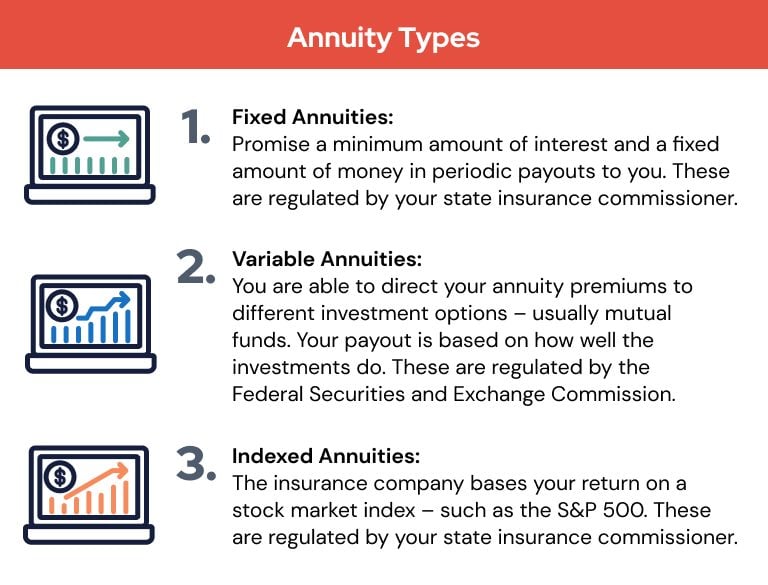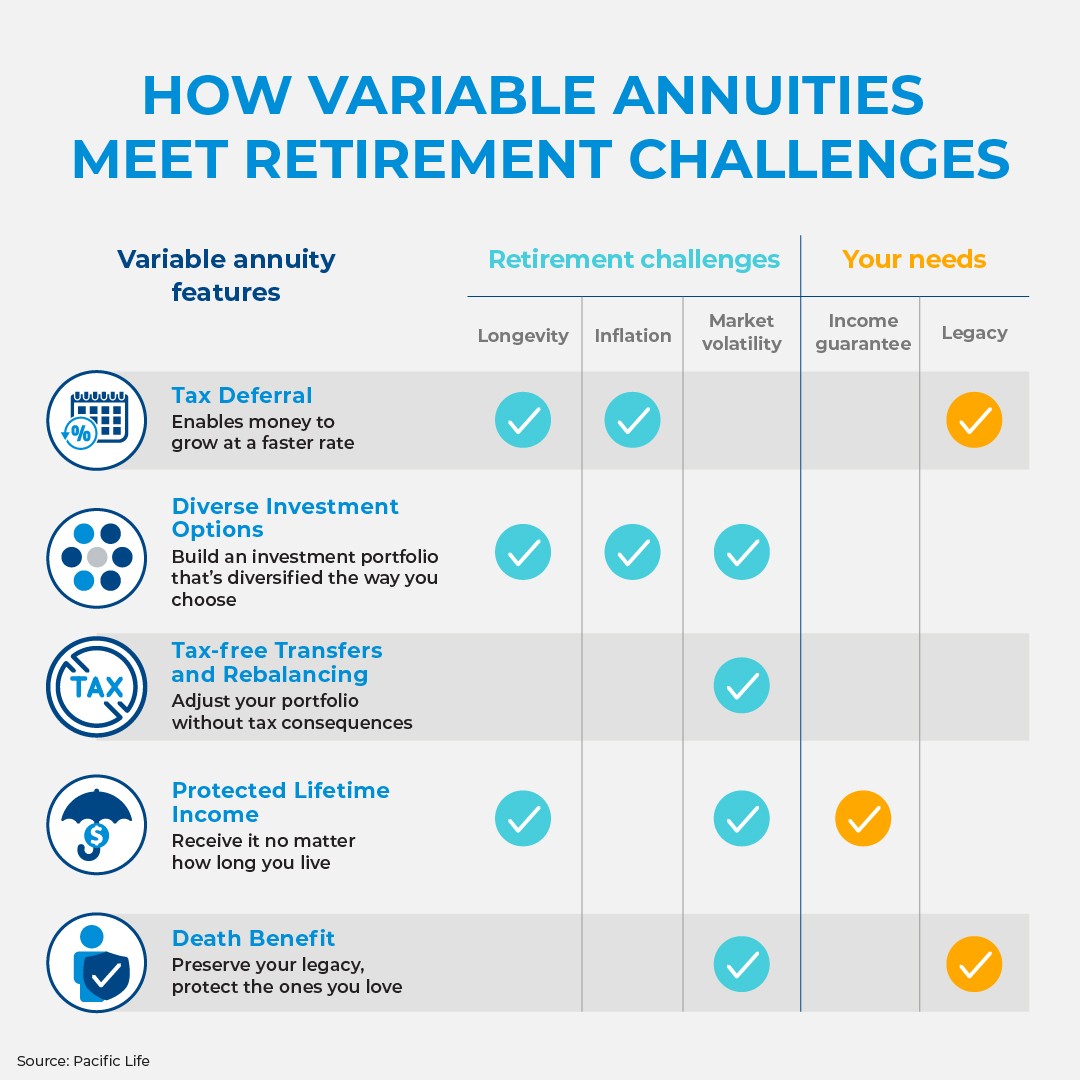All Categories
Featured
Table of Contents
Equally as with a fixed annuity, the owner of a variable annuity pays an insurance policy business a round figure or series of payments for the pledge of a collection of future settlements in return. However as pointed out above, while a fixed annuity expands at an assured, consistent price, a variable annuity grows at a variable price that depends upon the efficiency of the underlying investments, called sub-accounts.

During the build-up stage, possessions purchased variable annuity sub-accounts expand on a tax-deferred basis and are tired only when the contract owner takes out those incomes from the account. After the buildup stage comes the revenue stage. Over time, variable annuity assets should in theory boost in worth until the agreement proprietor decides he or she want to start withdrawing money from the account.
The most significant issue that variable annuities normally present is high price. Variable annuities have a number of layers of costs and expenses that can, in aggregate, produce a drag of up to 3-4% of the agreement's value each year.
Understanding Financial Strategies Key Insights on Fixed Annuity Or Variable Annuity What Is the Best Retirement Option? Advantages and Disadvantages of Fixed Annuity Vs Variable Annuity Why Indexed Annuity Vs Fixed Annuity Is a Smart Choice How to Compare Different Investment Plans: Explained in Detail Key Differences Between Variable Vs Fixed Annuity Understanding the Risks of Long-Term Investments Who Should Consider Choosing Between Fixed Annuity And Variable Annuity? Tips for Choosing the Best Investment Strategy FAQs About Planning Your Financial Future Common Mistakes to Avoid When Planning Your Retirement Financial Planning Simplified: Understanding Your Options A Beginner’s Guide to Smart Investment Decisions A Closer Look at How to Build a Retirement Plan
M&E expenditure charges are computed as a percentage of the agreement value Annuity providers pass on recordkeeping and various other administrative costs to the contract owner. This can be in the form of a flat yearly cost or a portion of the contract value. Administrative fees might be included as part of the M&E danger cost or might be examined individually.
These costs can vary from 0.1% for passive funds to 1.5% or more for proactively handled funds. Annuity contracts can be customized in a variety of methods to offer the details needs of the agreement proprietor. Some usual variable annuity bikers include assured minimum accumulation advantage (GMAB), guaranteed minimum withdrawal advantage (GMWB), and ensured minimum earnings benefit (GMIB).
:max_bytes(150000):strip_icc()/VariableAnnuitization-asp-v1-5dedf8fee4694d8dacd2ac7eb7b0757e.jpg)
Variable annuity payments offer no such tax reduction. Variable annuities have a tendency to be very ineffective vehicles for passing riches to the future generation since they do not appreciate a cost-basis modification when the initial contract proprietor passes away. When the proprietor of a taxed investment account dies, the cost bases of the investments kept in the account are adapted to reflect the market prices of those financial investments at the time of the owner's death.
Breaking Down Your Investment Choices Key Insights on Annuity Fixed Vs Variable Defining the Right Financial Strategy Pros and Cons of Various Financial Options Why Choosing the Right Financial Strategy Matters for Retirement Planning How to Compare Different Investment Plans: How It Works Key Differences Between Different Financial Strategies Understanding the Rewards of Indexed Annuity Vs Fixed Annuity Who Should Consider Strategic Financial Planning? Tips for Choosing the Best Investment Strategy FAQs About Variable Annuity Vs Fixed Annuity Common Mistakes to Avoid When Choosing a Financial Strategy Financial Planning Simplified: Understanding Your Options A Beginner’s Guide to Fixed Income Annuity Vs Variable Annuity A Closer Look at How to Build a Retirement Plan
Such is not the instance with variable annuities. Investments held within a variable annuity do not obtain a cost-basis adjustment when the original owner of the annuity passes away.
One substantial concern associated with variable annuities is the possibility for problems of rate of interest that may feed on the part of annuity salesmen. Unlike a financial advisor, who has a fiduciary responsibility to make investment decisions that profit the customer, an insurance coverage broker has no such fiduciary responsibility. Annuity sales are very rewarding for the insurance experts that sell them because of high upfront sales commissions.

Several variable annuity contracts consist of language which places a cap on the percentage of gain that can be experienced by particular sub-accounts. These caps stop the annuity owner from fully joining a section of gains that could otherwise be enjoyed in years in which markets generate substantial returns. From an outsider's viewpoint, it would certainly appear that financiers are trading a cap on investment returns for the abovementioned assured floor on investment returns.
As noted above, give up costs can severely limit an annuity proprietor's capability to move assets out of an annuity in the very early years of the contract. Additionally, while a lot of variable annuities allow agreement owners to withdraw a defined amount during the build-up phase, withdrawals yet quantity generally result in a company-imposed cost.
Withdrawals made from a set interest price investment alternative could additionally experience a "market price modification" or MVA. An MVA adjusts the worth of the withdrawal to mirror any modifications in rate of interest from the time that the cash was purchased the fixed-rate alternative to the time that it was taken out.

Frequently, even the salesmen that sell them do not fully understand exactly how they work, and so salesmen sometimes exploit a customer's emotions to offer variable annuities instead than the benefits and viability of the products themselves. We believe that capitalists ought to completely comprehend what they have and how much they are paying to have it.
Breaking Down Your Investment Choices A Closer Look at Tax Benefits Of Fixed Vs Variable Annuities Breaking Down the Basics of Fixed Income Annuity Vs Variable Annuity Features of Smart Investment Choices Why Choosing the Right Financial Strategy Is a Smart Choice Fixed Interest Annuity Vs Variable Investment Annuity: A Complete Overview Key Differences Between Different Financial Strategies Understanding the Rewards of Long-Term Investments Who Should Consider Strategic Financial Planning? Tips for Choosing Retirement Income Fixed Vs Variable Annuity FAQs About Tax Benefits Of Fixed Vs Variable Annuities Common Mistakes to Avoid When Planning Your Retirement Financial Planning Simplified: Understanding Your Options A Beginner’s Guide to Smart Investment Decisions A Closer Look at How to Build a Retirement Plan
Nevertheless, the same can not be said for variable annuity assets kept in fixed-rate investments. These possessions lawfully come from the insurer and would therefore be at threat if the firm were to fall short. Any kind of warranties that the insurance business has actually agreed to provide, such as a guaranteed minimum earnings advantage, would certainly be in concern in the event of a business failure.
For that reason, prospective buyers of variable annuities need to recognize and take into consideration the economic problem of the providing insurer before becoming part of an annuity contract. While the advantages and downsides of different kinds of annuities can be disputed, the actual concern bordering annuities is that of viability. In other words, the concern is: that should possess a variable annuity? This inquiry can be challenging to answer, offered the myriad variants offered in the variable annuity cosmos, however there are some basic standards that can assist financiers choose whether or not annuities need to play a duty in their financial strategies.
As the saying goes: "Purchaser beware!" This short article is prepared by Pekin Hardy Strauss, Inc. Retirement planning with annuities. ("Pekin Hardy," dba Pekin Hardy Strauss Wealth Administration) for educational functions only and is not planned as a deal or solicitation for organization. The details and data in this write-up does not comprise lawful, tax, bookkeeping, financial investment, or various other expert guidance
Table of Contents
Latest Posts
Breaking Down Fixed Vs Variable Annuity Pros Cons A Comprehensive Guide to Fixed Index Annuity Vs Variable Annuity Breaking Down the Basics of Investment Plans Benefits of Choosing the Right Financial
Breaking Down Fixed Annuity Vs Variable Annuity Everything You Need to Know About Financial Strategies Breaking Down the Basics of Investment Plans Benefits of Pros And Cons Of Fixed Annuity And Varia
Decoding What Is A Variable Annuity Vs A Fixed Annuity Key Insights on Your Financial Future Defining Variable Vs Fixed Annuities Benefits of Fixed Vs Variable Annuity Why Choosing the Right Financial
More
Latest Posts